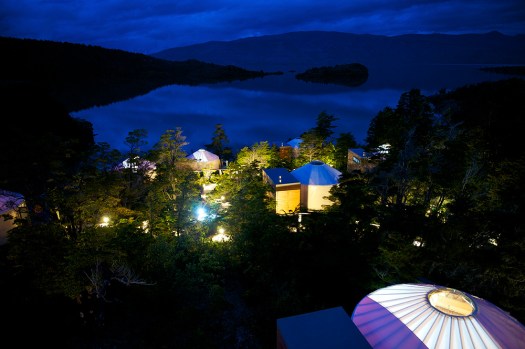Ever since the Papaya Playa Project graced the palm-kissed shores of Tulum, Mexico in December 2011 as a pop-up with a long-term plan, I’ve been plotting my visit.
As a glamping-obsessed adventurer with a penchant for design, I couldn’t ignore the location’s raw beauty and the architecture’s thatched-roof abodes. Plus, the lure of living like a beach bohemian without a hairdryer, plush hotel slippers, or the pressure to strut around in resort wear was a welcome departure from the Riviera Maya’s jet-set hotels.

Stretching over a 900 meter ribbon of private oceanfront just a mile North of Tulum’s never-ending beach, Papaya Playa’s 80 bungalows dot the shoreline of the multi-acre property.

Beyond the beach, pounded dirt pathways plying through the jungle thicket connect the glamp-ground’s casitas to its hub: A palm-shaded, amphitheatre-style restaurant that quadruples as a music venue, a place to chill with a cervesa when lounging at the Beach Club, and a space for the property’s once-monthly full moon parties. (If your stay coincides with a full moon party and you don’t want to dance until 3 a.m., bring ear plugs.)

Each abode’s union of artisan furniture, beds adorned with cascading mosquito nets, basket lights, string-secured wooden towel holders, and custom-designed textiles is enough to make you say “Viva Mexico,” but it’s the eco angle that makes you pine after your perch; every building from casita to casa to the spa’s temazcal (Mesoamerican sweat lodge) is built using local materials.

When I stepped into my circular beach-view abode complete with a 10-step pathway down to the shore, I immediately opened the sliding glass doors to let the wind and waves “soundtrack” invite me deeper into paradise. Settling into the wooden-slat chair on my deck, I realized how easy it would be to become a hermit—why would I leave such an idyllic perch? Yet, the lure of the property’s other spaces, think: the spa, juice shack, restaurant, bar, and beach palapas called me outward.

While I loved my minimalist casita (with an air-conditioning upgrade), its designated four-post beach palapa became the object of my Papaya Playa desires. Topped with palm fronds from the property, a teal beach mattress lay underneath propped up by a handmade headboard. Not surprisingly, this is where I spent the majority of my time alternating between catnaps and Caribbean Sea cool-downs.

As the sun retreated at the end of my easy-breezy beach days, looking back, I realize I was in no rush to wash off the salt and sand, and move on to guacamole and margaritas. With sustenance a short stroll away, and the sky splashed in tangerine and fuchsia hues, I was content to be—be in my bathing suit, be barefoot, be in the moment. That’s what beachfront glamping does to your soul.

Know this: Rates include bottled water, palm-covered palapas, beach towels and parking. Complimentary WiFi is available in public areas, though it runs off a satellite so the signal may take the occasional siesta. If you sleep well in cool conditions, book a bungalow with air conditioning. Mosquito repellant is recommended for any off-beach activity. Adrenaline junkies: There’s a kiteboarding and surf school onsite.


















